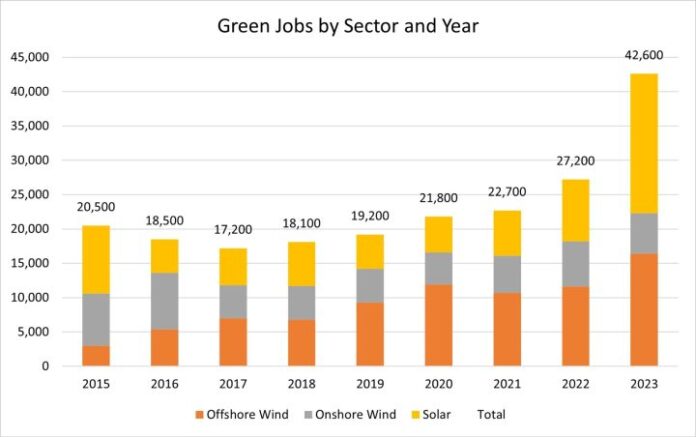From THE DAILY SCEPTIC
by David Turver
I recently published an article that included an update on the cost of green jobs. However, since then more recent data has been published by the ONS. Ed Miliband is still boasting about creating good jobs in clean renewables, so it is worth checking in from time to time to see how much these jobs actually cost the rest of us. The detailed results from the more recent data warrant a standalone article.
How Many Green Jobs are There?
From time to time, the ONS publishes data on the number of green jobs in the economy. The most recent data was published on July 18th 2025 and gives data for 2023.
The total number of green jobs in 2023 is alleged to be 690,900 up from 513,300 in 2015. Of these, 45,200 people were employed in environmental charities, 17,700 in environmental consulting and a staggering 19,400 were employed in “managerial activities of government bodies”. The lanyard class in action.
In the renewable energy sector, the number of full-time equivalent jobs in the UK for offshore wind, onshore wind and solar was 16,400, 5,900 and 20,300, respectively. As shown in Figure 1, the number of jobs in these sectors rose substantially in 2023.
The increase was caused by the number of jobs in solar power more than doubling alongside a substantial increase in offshore wind jobs. Of course such a substantial increase in renewables jobs means the energy sector is becoming less productive and of course the energy generated will likely be more expensive.
How Much do Wind and Solar Power Receive in Subsidy?
There are three subsidy regimes for renewable energy in the UK. These are Feed-in-Tariffs (FiTs), Renewables Obligation Certificates (ROCs) and Contracts for Difference (CfDs).
Each year Ofgem publish the FiT report and dataset that details the total amount of electricity generated, total payments and the capacity installed by technology. In scheme year 14, running from April 2023 to March 2024, the total payments under the FiT scheme were £1,840 million. If we split these payments by installed capacity, we find that solar power received £1,460 million in FiT payments and wind (assumed to be onshore) received £218 million.
Details of ROCs issued can be found on the Ofgem portal. The value of ROCs related to the output period for 2023/24 was £2,618 million for offshore wind, £1,555 million for onshore wind and £561 million for solar power.
The Low Carbon Contracts Company publishes a database of CfD payments that can also be split by technology. The period 2023/24 showed subsidies increasing because gas prices subsided after the energy crisis. Offshore wind received £1,721 million in 2023/24. Because strike prices for onshore wind and solar power tend to be lower than for offshore wind, these two technologies received £55 million and £0.5 million, respectively.
The total subsidies in 2023/24 for these three sectors are around £8.1 billion. We can expect current year subsidies to be higher because all the subsidy schemes are index-linked, pushing up the value of ROCs and FiT payments. CfD strike prices have been indexed upwards too and, because the price of gas has fallen, the reference prices have fallen as well, leading to another increase in subsidies.
What is the Cost of Green Jobs?
Pulling all this together, we can add up the total subsidy received for these technologies and compare it to the number of jobs in each sector.

We can see that each offshore wind job cost £264,000 in subsidy, each onshore wind job cost over £309,000 and solar nearly £100,000. The average across all three sectors is over £192,000 per job.
Now remember, this is not a one-off payment to get a new industry up and running, it is an ongoing annual payment. The ONS does not publish its estimate of the salaries in the sector, however, the annual subsidies are far higher than any reasonable estimate of the average salaries paid in the sector.
Conclusions
It is crystal clear that all talk of a “green revolution” is simply a pipe dream. These green jobs are only a façade, Potemkin jobs to give politicians and policymakers a good sound bite and make them feel good about themselves. The idea that we can move to “green prosperity” by subsidising each job to the tune of £192,000 every year is plainly absurd. These jobs are a drag on the rest of the economy, acting as a tax on energy. We need to end this economic fantasy.
David Turver writes the Eigen Values Substack page, where this article first appeared.
Related
Discover more from Watts Up With That?
Subscribe to get the latest posts sent to your email.
